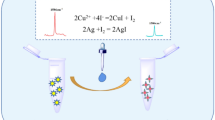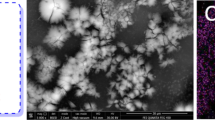Abstract
Based on the Lewis acid’s coordination principle, a surface-enhanced Raman scattering (SERS) chip strategy had been developed for the ultrasensitive quantitation of SO42−. Through the immobilization of silver nanoparticles (Ag NPs) and the construction of the boric acid-based sensing unit, the chip system displayed outstanding merits on the direct sensing of SO42−, e.g., simple operation, ultra-high sensitivity, reproducibility, excellent selectivity and specificity. Moreover, an accurate evaluation was obtained by ratiometric calculations on characteristic peaks (1382 and 1070 cm−1) for quantitative detection of SO42−. The detection limit was down to 10 nM. Tap water, beer, and mineral water samples were tested, and high recoveries were achieved (97.12–110.12%). Besides, such SERS chip also displayed strong applicability for the evaluation of SO32−. Therefore, this SERS chip provided a promising idea for the quantification of trace amounts of SO42− and SO32− in the fields of food safety and environmental monitoring.
Graphical abstract








Similar content being viewed by others
References
J. Wang, L. Liu, W. Xu, Z. Yang, Y. Yan, X. Xie, Y. Wang, T. Yi, C. Wang, J. Hua, Mitochondria-targeted ratiometric fluorescent probe based on diketopyrrolopyrrole for detecting and imaging of endogenous superoxide anion in vitro and in vivo. Anal. Chem. 91, 5786–7593 (2019)
H. Zhou, Y. Zhao, G. Gao, S. Li, J. Lan, J. You, Highly selective fluorescent recognition of sulfate in water by two rigid tetrakisimidazolium macrocycles with peripheral chains. J. Am. Chem. Soc. 135, 14908–14911 (2013)
L. Qin, A. Hartley, P. Turner, R.B.P. Elmes, K.A. Jolliffe, Macrocyclic squaramides: anion receptors with high sulfate binding affinity and selectivity in aqueous media. Chem. Sci. 7, 4563–4572 (2016)
L.C. Backer, Assessing the acute gastrointestinal effects of ingesting naturally occurring, high levels of sulfate in drinking water. Crit. Rev. Clin. Lab. Sci. 37, 389–400 (2000)
S.V. Lomako, R.I. Astapovich, O.V. Nozdrin-Plotnitskaya, T.E. Pavlova, S. Lei, V.A. Nazarov, E.B. Okaev, E.M. Rakhman’ko, V.V. Egorov, Sulfate-selective electrode and its application for sulfate determination in aqueous solutions. Anal. Chim. Acta 562, 216–222 (2006)
M.A. Travassos Lemos, R.J. Cassella, D.P. de Jesus, A simple analytical method for determining inorganic anions and formate in virgin olive oils by capillary electrophoresis with capacitively coupled contactless conductivity detection. Food Control 57, 327–332 (2015)
A.F. Campos, R.J. Cassella, Development of an extraction method for the determination of inorganic anions (chloride, sulfate and phosphate) in edible oils from different origins by ion chromatography. J. Food Sci. Technol. 55, 3922–3929 (2018)
M. Colon, M. Iglesias, M. Hidalgo, J.L. Todolí, Sulfide and sulfate determination in water samples by means of hydrogen sulfide generation-inductively coupled plasma-atomic emission spectrometry. J. Anal. At. Spectrom. 23, 416–418 (2008)
W. Ji, L. Li, Y. Zhang, X. Wang, Y. Ozaki, Recent advances in surface-enhanced Raman scattering-based sensors for the detection of inorganic ions: sensing mechanism and beyond. J. Raman Spectrosc. 52, 468–481 (2020)
X.X. Han, R.S. Rodriguez, C.L. Haynes, Y. Ozaki, B. Zhao, Surface-enhanced Raman spectroscopy. Nat. Rev. Methods Prim. 1, 1–17 (2022)
H.-S. Su, H.-S. Feng, X. Wu, J.-J. Sun, B. Ren, Recent advances in plasmon-enhanced Raman spectroscopy for catalytic reactions on bifunctional metallic nanostructures. Nanoscale 13, 13962–13975 (2021)
H. Ma, S. Liu, Y. Liu, J. Zhu, X.X. Han, Y. Ozaki, B. Zhao, In-situ fingerprinting phosphorylated proteins via surface-enhanced Raman spectroscopy: single-site discrimination of Tau biomarkers in Alzheimer’s disease. Biosens. Bioelectron. 171, 112748 (2021)
H. Zhao, J. Jin, W. Tian, R. Li, Z. Yu, W. Song, Q. Cong, B. Zhao, Y. Ozaki, Three-dimensional superhydrophobic surface-enhanced Raman spectroscopy substrate for sensitive detection of pollutants in real environments. J. Mater. Chem. A 3, 4330–4337 (2015)
C. Pan, H. Chen, Q. Lin, S. Luo, J. Gu, S. Ye, Y. Zeng, B. Ren, Z. Tian, W. Xue, G. Liu, Evaluation of the SERS-based strategy in fast and on-site food safety inspection: qualitative and quantitative analysis of trace unexpected herbicide in complicated herbicide matrix. J. Raman Spectrosc. 51, 2562–2567 (2020)
M.L. Xu, Y. Gao, X.X. Han, B. Zhao, Detection of Pesticide Residues in Food Using Surface-Enhanced Raman Spectroscopy: A Review. J. Agric. Food Chem. 65, 6719–6726 (2017)
L. Guerrini, R.A. Alvarez-Puebla, Multiplex SERS chemosensing of metal ions via DNA-mediated recognition. Anal. Chem. 91, 11778–11784 (2019)
W. Ji, B. Zhao, Y. Ozaki, Semiconductor materials in analytical applications of surface-enhanced Raman scattering. J. Raman Spectrosc. 47, 51–58 (2016)
W. Ji, L. Li, Y. Zhang, X. Wang, Y. Ozaki, Recent advances in surface-nhanced Raman scattering-based sensors for the detection of inorganic ions: sensing mechanism and beyond. J Raman Spectrosc 52, 468–481 (2021)
Z.-Y. Chen, A. Gupta, S. Chattopadhyay, Detection of mercury in spiked cosmetics by surface enhanced Raman spectroscopy using silver shelled iron oxide nanoparticles. Sens. Actuators B 337, 129788 (2021)
H. Zhuang, Z. Wang, X. Zhang, J.A. Hutchison, W. Zhu, Z. Yao, Y. Zhao, M. Li, A highly sensitive SERS-based platform for Zn(ii) detection in cellular media. Chem. Commun. 53, 1797–1800 (2017)
I. Ravikumar, P. Ghosh, Recognition and separation of sulfate anions. Chem. Soc. Rev. 41, 3077–3098 (2012)
N. Busschaert, L.E. Karagiannidis, M. Wenzel, C.J.E. Haynes, N.J. Wells, P.G. Young, D. Makuc, J. Plavec, K.A. Jolliffe, P.A. Gale, Synthetic transporters for sulfate: a new method for the direct detection of lipid bilayer sulfate transport. Chem. Sci. 5, 1118 (2014)
B. Gao, Z.F. Liu, A first principles study on the solvation and structure of SO42- (H2O)n, n=6-12. J. Chem. Phys. 121, 8299–8306 (2004)
V.J. Dungan, H.T. Ngo, P.G. Young, K.A. Jolliffe, High affinity sulfate binding in aqueous media by cyclic peptides with thiourea arms. Chem. Commun. 49, 264–266 (2013)
R.B. Elmes, K.K. Yuen, K.A. Jolliffe, Sulfate-selective recognition by using neutral dipeptide anion receptors in aqueous solution. Chemistry 20, 7373–7380 (2014)
S.K. Kim, J. Lee, N.J. Williams, V.M. Lynch, B.P. Hay, B.A. Moyer, J.L. Sessler, Bipyrrole-strapped calix[4]pyrroles: strong anion receptors that extract the sulfate anion. J. Am. Chem. Soc. 136, 15079–15085 (2014)
P.A. Gale, J.R. Hiscock, C.Z. Jie, M.B. Hursthouse, M.E. Light, Acyclic indole and carbazole-based sulfate receptors. Chem. Sci. 1, 215 (2010)
C.M. Lopez-Alled, A. Sanchez-Fernandez, K.J. Edler, A.C. Sedgwick, S.D. Bull, C.L. McMullin, G. Kociok-Kohn, T.D. James, J. Wenk, S.E. Lewis, Azulene-boronate esters: colorimetric indicators for fluoride in drinking water. Chem. Commun. 53, 12580–12583 (2017)
L. Li, C. Wang, L. Yang, M. Su, F. Yu, L. Tian, H. Liu, Conformational sensitivity of surface selection rules for quantitative Raman identification of small molecules in biofluids. Nanoscale 10, 14342–14351 (2018)
H. Li, H. Xia, D. Wang, X. Tao, Simple synthesis of monodisperse, quasi-spherical, citrate-stabilized silver nanocrystals in water. Langmuir 29, 5074–5079 (2013)
F. Pi, P. Dillard, L. Limozin, A. Charrier, K. Sengupta, Nanometric protein-patch arrays on glass and polydimethylsiloxane for cell adhesion studies. Nano Lett. 13, 3372–3378 (2013)
C.R. Wade, A.E.J. Broomsgrove, S. Aldridge, F.P. Gabbaï, Fluoride ion complexation and sensing using organoboron compounds. Chem. Rev. 110, 3958–3984 (2010)
X. Yue, Y. Su, X. Wang, L. Li, W. Ji, Y. Ozaki, Reusable silicon-based sers chip for ratiometric analysis of fluoride ion in aqueous solutions. ACS Sens. 4, 2336–2342 (2019)
H. Su, Y. Wang, Z. Yu, Y. Liu, X. Zhang, X. Wang, H. Sui, C. Sun, B. Zhao, Surface-enhanced Raman spectroscopy study on the structure changes of 4-mercaptophenylboronic acid under different pH conditions. Spectrochim. Acta, Part A 185, 336–342 (2017)
K. Ariga, H. Ito, J.P. Hill, H. Tsukube, Molecular recognition: from solution science to nano/materials technology. Chem. Soc. Rev. 41, 5800–5835 (2012)
R. Peng, Y. Si, T. Deng, J. Zheng, J. Li, R. Yang, W. Tan, A novel SERS nanoprobe for the ratiometric imaging of hydrogen peroxide in living cells. Chem. Commun. 52, 8553–8556 (2016)
Acknowledgements
This work was financially supported by the Innovation and Entrepreneurship Projects and Six Talent Peaks Project of Jiangsu Province (No. SWYY-023); F.P. thanks for the support from National Natural Science Foundation of China (No. 21603087), Natural Science Foundation of Jiangsu Province (No. BK20160178).
Funding
Innovative Research Group Project of the National Natural Science Foundation of China, No. 21603087, Natural Science Foundation of Jiangsu Province, No. BK20160178, Six Talent Peaks Project in Jiangsu Province, No. SWYY-023.
Author information
Authors and Affiliations
Corresponding author
Supplementary Information
Below is the link to the electronic supplementary material.
Rights and permissions
Springer Nature or its licensor holds exclusive rights to this article under a publishing agreement with the author(s) or other rightsholder(s); author self-archiving of the accepted manuscript version of this article is solely governed by the terms of such publishing agreement and applicable law.
About this article
Cite this article
Gao, Y., Wan, Y., Liu, L. et al. Highly sensitive sensing and quantitative detection of sulfate ion with a SERS chip-based on boric acid’s Lewis effect. ANAL. SCI. 38, 1385–1394 (2022). https://doi.org/10.1007/s44211-022-00169-5
Received:
Accepted:
Published:
Issue Date:
DOI: https://doi.org/10.1007/s44211-022-00169-5




